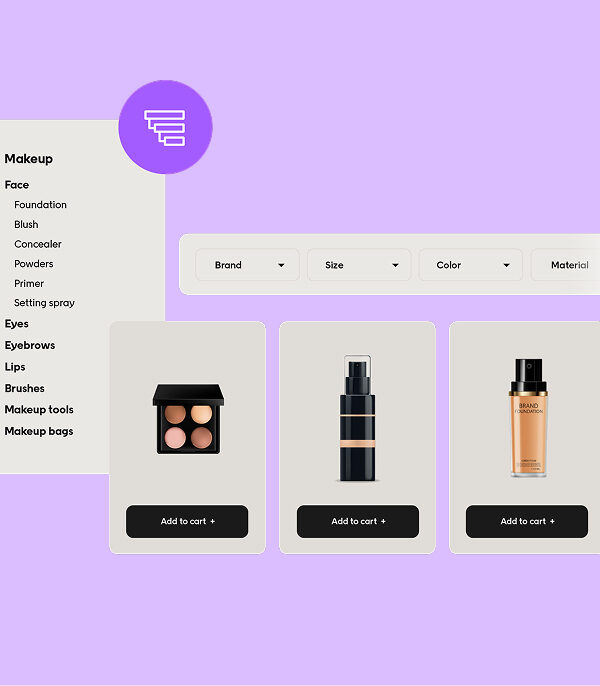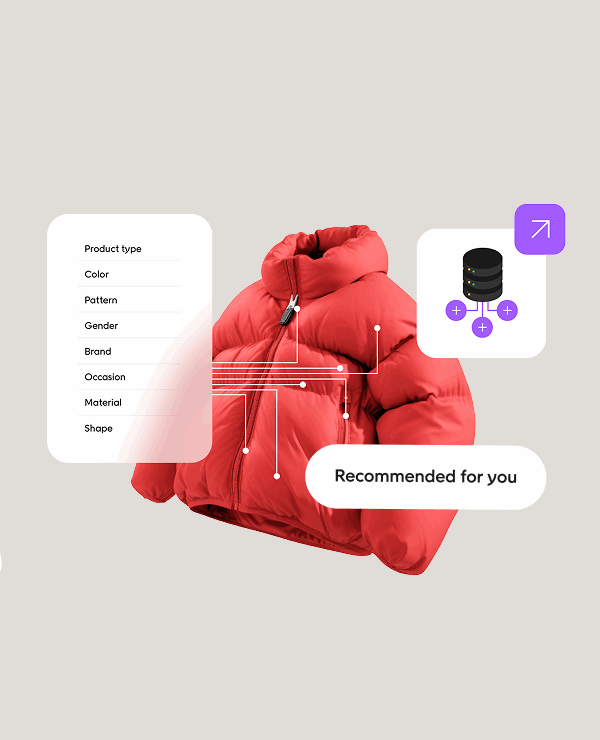TL;DR
Your 30-second overview
- Online merchandising involves displaying and managing products across your e-commerce site to engage customers and drive sales.
- It combines data, design, and merchandising strategy to deliver a better online shopping experience.
- AI-powered tools help personalize what each shopper sees, increasing relevance and conversions.
- When done right, online merchandising connects your online store and physical locations into one seamless experience.
- This approach builds customer loyalty, boosts sales, and strengthens your brand identity.
Your products might be great, but if customers can’t find them, they can’t buy them.
That’s where online merchandising comes in.
It’s the process that turns browsers into buyers by placing the right products, in the right spot, for the right audience.
Let’s take a closer look at what online merchandising means and how it helps e-commerce businesses grow.
What is online merchandising?
Online merchandising, also known as digital or e-commerce merchandising, is how online retailers organize and present products on their e-commerce websites.
It’s about guiding customers through the store, much like a visual display in a brick-and-mortar shop, but with data and personalization driving the experience.
The digital selling space
Your digital storefront includes:
- Product pages
- Category pages
- Search results
- Recommendation panels
- Promotional banners
Each of these touchpoints shapes the customer journey. The goal is to make product discovery effortless so shoppers can move from browsing to buying.
Visual merchandising online
In physical retail, presentation is everything. The same principle applies online. Strong product images, videos, and clear product descriptions increase engagement.
Adding user-generated content, reviews, and social proof can further boost trust and improve the overall shopping experience.
Building structure and flow
Online merchandising isn’t just about visuals. It’s also about structure. Good design, intuitive filters, and a clean search bar help shoppers find relevant products faster.
Behind the scenes, your merchandising and marketing teams benefit too. A well-structured catalog supports campaign launches, pricing updates, and product rotations without breaking the customer experience.
Want to learn more about applying these principles in practice? Explore e-commerce merchandising for tactical guidance and examples from leading retailers.
Why online merchandising matters for your business
Your e-commerce success depends on how well you connect your products to your customers.
Online merchandising does exactly that. It uses data, design, and smart product placement to create an experience that feels natural and profitable.
Why it’s critical to success
Competition in e-commerce is fierce. Customers have endless options, and their attention spans are short. A clear online merchandising strategy helps you stand out and connect each shopper with relevant products.
Here’s why it matters:
- Relevance increases sales. Smart product placement ensures that customers see the items most likely to convert.
- Experience drives engagement. A consistent shopping experience across channels builds confidence and encourages future purchases.
- Data fuels growth. Customer data, preferences, and purchase history power more personalized experiences.
- Consistency builds loyalty. When your product presentation reflects your brand identity, customers remember you.
The psychology behind great merchandising
When shoppers land on your site, every detail matters – from product order to layout. Seeing relevant, appealing products builds trust and makes them more likely to stay.
Merchandising also shapes perception. It helps customers associate your brand with quality, clarity, and reliability. That emotional link is what drives customer loyalty and lifetime value.
Connecting digital and physical stores
Customers now shop across channels. A strong online merchandising strategy makes your online and offline stores feel like one connected experience.
It ensures your e-commerce site mirrors the look, tone, and feel of your brick-and-mortar store. This helps customers recognize your brand wherever they shop.
Next, let’s look at how retailers are automating this process to meet today’s expectations.
From manual to AI-powered merchandising
Data is now the driving force behind effective online merchandising. By combining predictive analytics with automation, retailers can react to customer behavior faster, boost sales, and keep product assortments relevant.
With Voyado’s AI-powered merchandising tools, you can automate product sorting, adapt to shopper intent, and make every product recommendation feel personal. All in real time.
The limits of manual merchandising
Manual merchandising can’t keep up with the pace of modern retail.
There are just too many products, with too many data points, and too little time.
Manual methods can lead to:
- Missed trends and slow reactions to customer behavior
- Inconsistent product placement across category pages
- Lost sales from poor product visibility
The rise of automation
AI and machine learning now power the most effective online merchandising strategies. These tools analyze customer behavior, context, and crowd data to automatically optimize product placement.
Benefits include:
- Dynamic product sorting based on shopper intent
- Predictive analytics to forecast demand
- Cross-selling and upselling opportunities tailored to each visitor
With AI-driven merchandising, every customer sees a product selection that matches their interests, increasing relevance and conversions.
To see how brands use these tools in practice, read online merchandising strategies.
Now let’s explore how this technology aligns with marketing and sales.
How online merchandising connects marketing, data, and sales
Online merchandising doesn’t work in isolation. It’s a bridge between your marketing campaigns, product data, and customer interactions.
Aligning marketing and merchandising
When marketing and merchandising teams collaborate, they can:
- Match on-site displays with live promotions
- Coordinate new arrivals with email campaigns
- Keep messaging consistent across ads, landing pages, and category pages
This ensures your brand speaks with one voice across channels.
Data as the common language
Customer data and analytics reveal what products perform best, which keywords drive traffic, and what audiences convert.
By feeding this data into your merchandising system, you can optimize product listings, improve product placement, and target the right audience.
It’s how online retailers transform their e-commerce sites into engines that respond in real time to shopper behavior.
Let’s look more closely at how data can improve the customer journey.
Understanding customer behavior through data
Every click, search, and purchase tells a story.
Using data to personalize experiences
Analyzing customer behavior helps your team identify which products are viewed, ignored, or added to the cart. From there, you can personalize recommendations and adjust category pages to keep products relevant.
Learning from site search
Site search is one of your strongest data sources. It shows what customers want in their own words.
Tracking site search patterns helps you fix gaps in your catalog, improve keyword targeting, and refine your e-commerce merchandising strategy.
Measuring what matters
Use analytics to monitor:
- Conversion rates by category
- Bounce and exit rates
- Search performance
- Revenue per visitor
These insights guide your next merchandising decisions and improve your e-commerce website’s ability to serve the right products to the right people.
Next, let’s connect these insights to better operations and pricing.
Turning insights into better inventory and pricing decisions
Online merchandising goes beyond presentation. It shapes how you manage stock, margins, and campaigns.
Smarter inventory management
When you track sales and customer demand, you can plan inventory more effectively. AI helps you predict bestsellers, reorder fast-moving items, and reduce overstock.
Dynamic pricing and product visibility
AI also supports dynamic pricing. It adjusts prices based on demand, market trends, or seasonality while keeping margins healthy.
Meanwhile, automated product listings ensure new arrivals and top performers stay visible. This helps your merchandising team manage updates without slowing down operations.
Connecting merchandising to business goals
By aligning your online merchandising with marketing and inventory planning, your store stays agile. Your shoppers see relevant products. Your team stays informed.
And your e-commerce business becomes more responsive to real-time changes in customer behavior.
Now let’s look at the human side of merchandising.
Human and machine: A winning combination
AI can process data, but people bring the creativity and empathy that drive emotional loyalty.
The role of human merchandisers
Your team’s expertise in storytelling, visuals, and branding gives your merchandising a unique touch.
They know how to evoke feelings through design, color, and copy.
The role of automation
Automation handles the repetitive, data-heavy tasks. It keeps product displays fresh, updates sort orders, and surfaces trending items in real time.
Your team focuses on what truly connects with shoppers: storytelling, campaign ideas, and visual presentation that reflect your brand.
With Voyado’s editorial merchandising features, you can easily highlight curated collections, seasonal campaigns, and brand storytelling in ways that feel both creative and consistent across every page.
When humans and machines work together, you get the best of both worlds: efficiency and creativity.
Creating emotional connections
To make your online store memorable, focus on:
- Consistent product presentation
- Compelling product descriptions
- High-quality visuals
- Real customer testimonials and reviews
Together, these create trust and build long-term customer loyalty.
Let’s finish with how you can start improving your own merchandising strategy.
Over to you: Take your merchandising to the next level
Online merchandising is the foundation of a great online shopping experience.
Here’s how to start improving right now:
- Review your current site layout and category pages.
- Analyze customer data to understand buying behavior.
- Automate what you can to save time and increase accuracy.
- Keep visuals and product listings consistent with your brand identity.
When you combine technology, data, and creativity, you create a shopping experience that stands out and keeps customers coming back.
Want to see how Voyado helps retailers deliver smarter merchandising strategies?
Book a demo today to see what your business could achieve.
FAQs
What is online merchandising in e-commerce?
It’s how you organize and display products across your e-commerce site to make them easier to find and buy. It includes product listings, search results, category pages, and recommendation panels.
How is online merchandising different from traditional retail merchandising?
In physical stores, every shopper sees the same layout. Online merchandising is dynamic. It uses data and AI to adapt the experience for each visitor and product.
How does online merchandising improve the shopping experience?
It makes product discovery simple. Customers find what they want faster, see products that match their interests, and enjoy a consistent experience across channels.
How can AI improve my merchandising strategy?
AI tools help personalize recommendations, automate sorting, and track customer behavior. They use predictive analytics to adjust product placement and pricing in real time.
What should I measure to know if my strategy works?
Track metrics like conversion rates, average order value, site search performance, and repeat purchases. These show how well your merchandising efforts drive sales and engagement.










